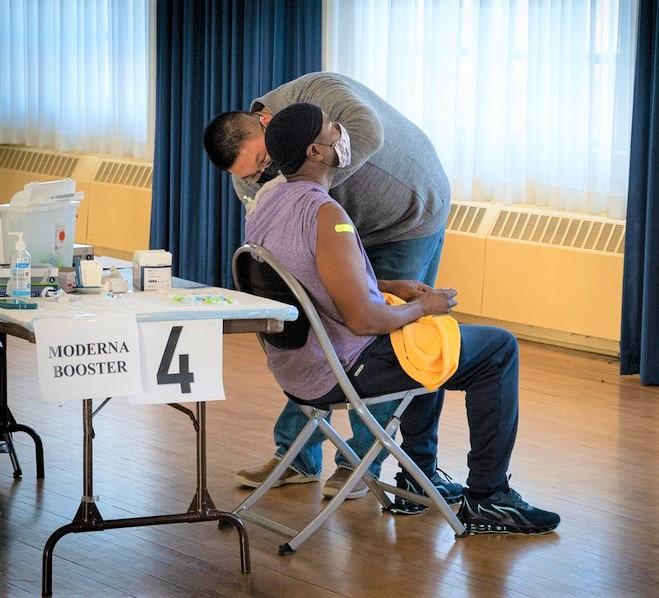Two reports yesterday in the New England Journal of Medicine detail the effects of the COVID-19 vaccine booster on Omicron (B.1.1.529) variant antibody levels, one finding that concentrations were 20 times higher after a third Moderna vaccine dose than after the primary series, and the other showing the benefits of longer intervals between doses.
20-fold jump in Omicron antibodies after booster
In the first study, a team led by Moderna scientists assessed neutralizing antibody responses to a third Moderna vaccine dose against the Omicron variant versus the wild-type (D614G), Beta (B1351), and Delta (B1617.2) strains. The study built upon a pilot study that found that vaccine immune response to Omicron was lower than that to the wild-type and Beta strains.
The researchers measured Omicron variant neutralization using serum samples from participants who had received the two-dose Moderna vaccine regimen in the Coronavirus Efficacy (COVE) phase 2 and 3 trials of that vaccine.
Participants were randomly assigned to receive either a third dose of the prototypical Moderna vaccine (the version available under an emergency use authorization for US adults), a 1:1 mix of the authorized vaccine and Beta variant messenger RNAs (mRNAs), or a 1:1 mix of Beta and Delta mRNAs.
The Moderna vaccine induced detectable antibodies against Omicron in 85% of participants 1 month after the second dose. The 50% inhibitory dilution (ID50) geometric mean titer was 35.0 times lower against Omicron than against the wild-type strain. Independently performed live-virus focus-reduction and pseudovirus neutralization tests yielded similar results.
Seven months after primary vaccine series completion, anti-Omicron antibodies were found in only 55% of participants, along with ID50 geometric mean titers 8.4 times lower than those against the wild-type virus.
A 50-micrograms (μg) booster dose of the prototypical Moderna COVID-19 vaccine was tied to ID50 geometric mean titers against Omicron that were 20.0 times higher than those measured 1 month after the second dose; these levels were 2.9 times lower than those against the wild-type virus.
Six months after a vaccine booster dose, concentrations of neutralizing antibodies against the Omicron variant were 6.3 times lower than peak levels measured 1 month after the booster. But all participants still had detectable neutralizing antibody concentrations.
Neutralizing antibody levels against Omicron fell faster than those against the wild-type virus 6 months after the COVID-19 booster, similar to the drop against the wild-type strain after the second Moderna dose. The booster dose was linked with longer durability of wild-type virus neutralization, which was 2.3 times lower 6 months after the booster injection than at 1 month after the booster.
The 100-μg booster doses of all three Moderna vaccines produced comparable ID50 geometric mean titers against Omicron; these levels were 2.5 to 2.6 times higher than those measured after the 50-μg booster dose of the prototypical Moderna vaccine and 1.4 to 1.5 times higher than peak concentrations against the wild-type virus 1 month after the second dose in the COVE trial. The strong boosting of neutralization against Omicron was similar to that against Delta and Beta.
The study authors said that the 20-fold jump in neutralizing antibodies against the Omicron variant may substantially reduce the risk of COVID-19 breakthrough infection.
4-month interval before booster
Led by researchers from the Chinese Academy of Sciences in Beijing, the second study analyzed concentrations of binding and neutralizing antibodies against the wild-type strain and variants of concern elicited by receipt of two doses and a booster of either an inactivated COVID-19 vaccine (eg, CoronaVac, BBIBP-CorV) or the ZF2001 protein subunit vaccine. These vaccines have been widely used in China and several other countries, the authors said.
Participants included COVID-19 survivors (convalescents) as well as those never infected with the virus. Those who received the ZF2001 vaccine were grouped according to the interval between the second and booster doses: one group (short interval) received the second primary dose 1 month after the first and the booster 1 month later, and the other group (long interval) received the second primary dose 1 month after the first and then the booster 4 months after the second.
The researchers used a pseudovirus to test the serum samples for SARS-CoV-2 antibodies. Reductions in the antibodies binding to the Omicron variant were larger among both ZF2001 groups than among those who received the inactivated vaccine or the convalescent group.
Among convalescents, 15 of 16 serum samples were negative for neutralizing antibodies against the Omicron variant, but antibodies in the sera of recipients of the inactivated vaccine and ZF2001 were still effective against Omicron.
Among recipients of three vaccine doses, 10 of 16 samples (62%) in the inactivated-vaccine group, 9 of 16 samples (56%) in the short-interval ZF2001 group, and 16 of 16 samples (100%) in the prolonged-interval ZF2001 group had neutralizing antibodies against Omicron.
In a fifth group of participants who also waited 4 months between the second and third ZF2001 dose but whose serum samples were collected 4 to 6 months after a third dose, 9 of 13 (69%) had neutralizing antibodies against Omicron.
Neutralizing antibody levels against Omicron were 17.4-fold lower than those against the wild-type virus among convalescents, 5.1-fold lower in the inactivated-vaccine group, 10.6-fold lower in the short-interval ZF2001 group, and 3.1-fold lower in the prolonged-interval ZF2001 group. A longer interval between the second primary COVID-19 vaccine dose and the booster also appeared to result in higher neutralizing antibody concentrations against all variants studied.
The authors said that the results support the use of multiple vaccine boosters and longer intervals between vaccine doses to protect against highly mutated variants such as Omicron in both previously vaccinated people and those who had survived COVID-19.
"Our results are in accordance with those of previous studies involving messenger RNA vaccine recipients," the researchers concluded. "Next-generation vaccines that stimulate broad protection against SARS-CoV-2 variants are also needed."




















